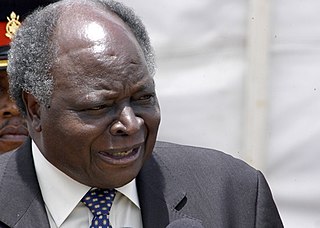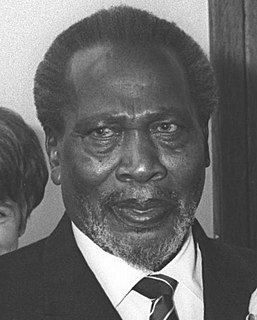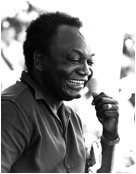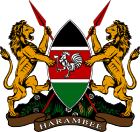
Daniel Toroitich arap Moi was a Kenyan statesman and politician who was the second and longest-serving President of Kenya from 1978 to 2002. He previously served as the third Vice President of Kenya from 1967 to 1978, and succeeded President Jomo Kenyatta following the latter's death.

The Kenya African National Union (KANU) is a Kenyan political party that ruled for nearly 40 years after Kenya's independence from British colonial rule in 1963 until its electoral loss in 2002. It was known as Kenya African Union (KAU) from 1944 to 1952. The KAU was banned by the colonial government from 1952 to 1960. It was re-established by James Gichuru in 1960 and renamed KANU on 14 May 1960 after a merger with Tom Mboya's Kenya Independence Movement.

Emilio Stanley Mwai Kibaki, C.G.H. was Kenyan politician who was the third President of Kenya, serving from December 2002 until April 2013.

The Kenya African Democratic Union (KADU) was a political party in Kenya. It was founded in 1960 when several leading politicians refused to join Jomo Kenyatta's Kenya African National Union (KANU). It was led by Ronald Ngala who was joined by Moi's Kalenjin Political Alliance, the Masai United Front, the Kenya African Peoples Party, the Coast African Political Union, Masinde Muliro's Baluhya Political Union and the Somali National Front. The separate tribal organisations were to retain their identity and so, from the very start, KADU based its political approach on tribalism. KADU's aim was to defend the interests of the so-called KAMATUSA as well as the British settlers, against the imagined future dominance of the larger Luo and Kikuyu that comprised the majority of KANU's membership, when it became inevitable that Kenya will achieve its independence. The KADU objective was to work towards a multiracial self government within the existing colonial political system. After release of Jomo Kenyatta, KADU was becoming increasingly popular with European settlers and, on the whole, repudiated Kenyatta's leadership. KADU's plan at Lancaster meetings was devised by European supporters, essentially to protect prevailing British settlers land rights.

Elections in Kenya take place within the framework of a multi-party democracy and a presidential system. The President, Senate and National Assembly are directly elected by voters, with elections organised by the Independent Electoral and Boundaries Commission (IEBC).

Forum for the Restoration of Democracy–Kenya (FORD–Kenya) is a Kenyan political party. It was part of the National Rainbow Coalition that governed Kenya from 2003 to 2007, having ended forty years of Kenya African National Union rule. It is allied to the Coalition for Reforms and Democracy which is the main opposition coalition in Kenya's parliament and is headed by Moses Wetangula, the Senator for Bungoma County.
The Orange Democratic Movement (ODM) is a centre-left political party in Kenya. It is the successor of a grassroots people's movement which was formed during the 2005 Kenyan constitutional referendum campaign. This movement separated in August 2007 into the Orange Democratic Movement Party of Kenya and the Wiper Democratic Movement – Kenya.

General elections were held in Kenya on 27 December 2002. Voters elected the President, and members of the National Assembly. They coincided with the 2002 Kenyan local elections.
This article contains detailed results of the parliamentary election that was held as part of the Kenyan general election in December 2007.

General elections were held in Kenya on 27 December 2007. Voters elected the President, and members of the National Assembly. They coincided with the 2007 Kenyan local elections.

General elections were held in Kenya on 29 December 1992. Voters elected the President, and members of the National Assembly. They were the first multi-party general elections in Kenya since independence and the first to feature a direct vote for the President, who had, in 1964, been elected by the National Assembly, and, following a 1969 constitutional amendment, been automatically declared winner of non-held popular elections, held alongside parliamentary elections, in 1969, 1974, 1979, 1983, and 1988.

General elections were held in Kenya on 29 December 1997. The result was a victory for the ruling Kenya African National Union, which won 107 of the 210 seats in the National Assembly, and whose candidate Daniel arap Moi won the presidential election. Following the election, Moi appointed a further 12 members to the Assembly.

General elections were held in Kenya on 21 March 1988. At the time, the county was a one-party state with the Kenya African National Union as the sole legal party. The size of the National Assembly was expanded from 158 to 188 seats prior to the elections. Although the post of President of Kenya was due to be elected at the same time as the National Assembly, Daniel arap Moi was the sole candidate and was automatically elected without a vote being held. Following the elections, a further 12 members were appointed by President Moi.
General elections were held in Kenya Colony between 18 and 26 May 1963. Voters elected members of the House of Representatives and Senate. The election was the last before independence later in the year.

General elections were held in Kenya on 6 December 1969, the first since independence in 1963. The country had become a de facto one-party state after President Jomo Kenyatta had banned the Kenya People's Union on 30 October, with Kenyatta's Kenya African National Union being the sole party to participate in the election. Although the post of President of Kenya was due to be elected at the same time as the National Assembly, Kenyatta was the sole candidate and was automatically elected without a vote being held.

General elections were held in Kenya on 14 October 1974. At the time, the country was a de facto one-party state with the Kenya African National Union being the sole party to participate in the election. 740 KANU candidates stood for the 158 National Assembly seats, with 88 incumbents defeated. Voter turnout was 56.5%. Although the post of President of Kenya was due to be elected at the same time as the National Assembly, Jomo Kenyatta was the sole candidate and was automatically elected without a vote being held. Following the election, a further 12 members were appointed by President Kenyatta.

General elections were held in Kenya on 8 November 1979. At the time, the country was a de facto one-party state with the Kenya African National Union being the sole party to participate in the election. A total of 742 KANU candidates stood for the 158 National Assembly seats, with more than half of the incumbents defeated. Voter turnout was 67.3%. Although the post of President of Kenya was due to be elected at the same time as the National Assembly, Daniel arap Moi was the sole candidate and was automatically elected without a vote being held. Following the elections, a further 12 members were appointed by President Moi.

General elections were held in Kenya on 26 September 1983. At the time, the country was a one-party state with the Kenya African National Union having been made the sole party the previous year. More than 750 KANU candidates stood for the 158 National Assembly seats, with around 40% of incumbents defeated. Voter turnout was 45.9%. Although the post of President of Kenya was due to be elected at the same time as the National Assembly, Daniel arap Moi was the sole candidate and was automatically elected without a vote being held. Following the elections, a further 12 members were appointed by President Moi.

Ronald Gideon Ngala (1923–1972) was a Kenyan politician who was the leader of the Kenya African Democratic Union political party from its creation in 1960 until its dissolution in 1964.

The African People's Party (APP) was a political party in Kenya.












